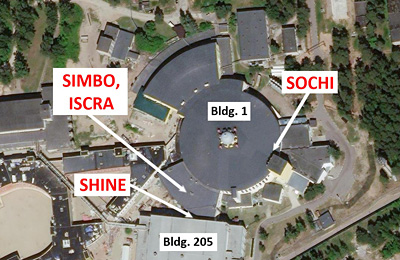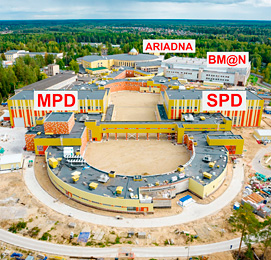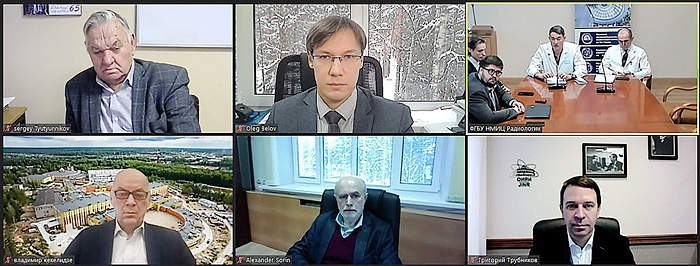
Electronic english version since 2022 |
The newspaper was founded in November 1957
| |
ARIADNA: In the Active Phase of Execution
 In recent months, a number of seminars, workshops and working meetings have been held to discuss the prospects for the development of applied research at the NICA complex. Thus, at the end of February, at a general laboratory seminar of VBLHEP, A.A.Slivin, an engineer of the Accelerator Department, spoke about the construction of appropriate facilities. The irradiation stations under construction are a basic element of the infrastructure for applied research at NICA, which received in 2021 the name ARIADNA (Applied Research Infrastructure for Advance Development at NICA fAcility). These are designed to conduct research in several main areas.
In recent months, a number of seminars, workshops and working meetings have been held to discuss the prospects for the development of applied research at the NICA complex. Thus, at the end of February, at a general laboratory seminar of VBLHEP, A.A.Slivin, an engineer of the Accelerator Department, spoke about the construction of appropriate facilities. The irradiation stations under construction are a basic element of the infrastructure for applied research at NICA, which received in 2021 the name ARIADNA (Applied Research Infrastructure for Advance Development at NICA fAcility). These are designed to conduct research in several main areas.
The first is testing for radiation resistance of microchips and work on radiation materials science. This will be implemented at the two stations currently being constructed. To irradiate decapsulated microchips with 3.2 MeV/nucleon ion beams extracted from the linear accelerator in VBLHEP's Building No.1, a Station Of CHip Irradiation (SOCHI) was installed in October-November last year, and in December it was physically launched with a carbon ion beam. In spring 2022, upon completion of the third commissioning cycle at the Booster, work at the station will continue. For research on radiation materials science and testing of encapsulated microchips in the energy range of 15-500 MeV/nucleon, it is planned to construct an Irradiation Station of Components of Radioelectronic Apparatus (ISCRA) in the measuring hall of Building No.1.
The second area is a wide range of studies in the field of life sciences using ion beams with energy in the range of 500-1000 MeV/nucleon. For these studies, a Station of Investigation of Medico-Biological Objects (SIMBO) will be constructed, also in the measuring hall of Building No.1.


The layout of the facilities (from A.A.Slivin's presentation).
The seminar provided the information about the state of progress of the SOCHI, ISCRA and SIMBO stations, about the team of specialists, equipment manufacturers, and partners of JINR involved in the work. The stations and beam channels for applied research are being constructed under the direction of E.M.Syresin, Chief Engineer of the NICA Accelerator Complex, with the decisive participation of young talented scientists G.A.Filatov and A.A.Slivin. The structure and appearance of the facilities and the detectors that comprise them were also explained in detail.
The greatest progress has been made in the construction of SOCHI - not only has the equipment already been assembled, but vacuum tests and a physical start-up have also been carried out at this station. In addition, the layouts of the ISCRA and SIMBO stations, their components, parameters, technical characteristics, location, as well as related systems - climate control and beam diagnostics system, were presented.
Work on the application channels and the station began in the Accelerator Department in 2019; now the reconstruction of the measuring hall of VBLHEP's Building No.1, where the equipment will be placed and the installation of the ISCRA and SIMBO stations is planned to start, is being completed. The commissioning of these stations is planned for late 2022.
In conclusion, Aleksei Askharovich spoke about the deadlines for completing the assembly of the facilities. The seminar moderator, E.S.Kokoulina, thanked A.A.Slivin for preparing a detailed presentation in the conditions of working in shifts of the acceleration run.
The seminar was, for obvious reasons, held via video conference and did not last long. This was the reason for asking O.V.Belov, Deputy Head of VBLHEP's Department for Methodological Research and Innovation, to elaborate on the direction he coordinates for the formation of the ARIADNA collaborations and on the activities to develop a scientific programme of applied research at the NICA complex and to develop cooperation with interested organizations.
- Oleg Valerievich, the first question is what would you add to A.A.Slivin's report?
- In addition to Aleksei's informative report, I would like to mention the third direction on the development of promising technologies for nuclear power problems, which is implemented under the leadership of A.A.Baldin. For such studies, a Station of High Energy Investigations in Nuclear Energetic (SHINE) is being constructed, which will also be available within the ARIADNA infrastructure. The design parameters of this station provide for the extraction of light-ion beams with energies up to 4 GeV/nucleon. And, of course, we should emphasize the efforts of a large team of scientists, engineers and specialists who were brought together to create ARIADNA irradiation stations and channels. Among them are employees of a number of scientific and research and production organizations, such as JINR, ITEP NRC "Kurchatov Institute", OOO "Vacuum Systems and Technologies" (Belgorod), OOO "GIRO-PROM", AO "IPTP" (Dubna), AO "ERPA SPELS", NRNU MEPhI, OOO "Ostek-EK" (Moscow), SINP MSU and others.
It is important to note that, in parallel with the activities aimed at constructing channels and irradiation stations, elements of the scientific programme of applied research at the NICA complex are being carefully developed. In recent months, these issues have been discussed at many discussion platforms, including a number of scientific conferences, seminars, workshops and working meetings.
- Which of the activities would you call fundamental in the implementation of work related to the channels for applied research at the NICA complex?
- Several such events have been organized at different times. So, in December 2016, an international meeting BIOMAT was held, which focused on discussing approaches to the development of equipment for channels and irradiation stations. A notable event of the past year, which gave a new impetus to the elaboration of the scientific programme for future research, was the International Round Table "Applied Research and Innovation at the NICA Complex" held on September 15-16. The event brought together more than 300 participants from Australia, Belarus, Belgium, Brazil, Bulgaria, China, Czech Republic, Germany, Italy, Japan, Moldova, Romania, Russia, South Africa, USA, Uzbekistan, as well as from international organizations -- the European Animal Research Association (EARA), European Space Agency (ESA), CERN, JINR, research institutes, R&D companies, educational institutions, and the media. Based on the results of reports and discussions, a Memorandum of the Round Table was adopted. The document reflects a considerable interest of the scientific community in the issues of organization of applied research at the NICA complex and the opinion of the participants about a number of strategic issues on the further development of works. In particular, the possibility of implementing a special mode of acceleration of charged particles with the fast change in particle energy was discussed for the first time. This mode is highly requested among users for simulating the effects of galactic cosmic rays on biological objects and technological systems.
The Memorandum of the Round Table also formalized the initiative to establish three collaborations within the framework of the NICA project in the areas of applied research related to the purpose of the channels being constructed.
- What actions followed the adoption of the Memorandum?
- To implement this proposal, we have started working out a process of joining the collaborations for interested scientific and scientific-technical institutes. At the moment, more than 20 organizations that have expressed their intentions to cooperate are involved in this process. As of early 2022, among the active members of collaboration were the Institute of Biomedical Problems of the Russian Academy of Sciences (RAS), the Burnazyan Federal Medical Biophysical Centre, the Semenov Institute of Chemical Physics of the RAS (Moscow), the Federal State Budgetary Institution "National Medical Research Centre of Radiology" (FSBI "NMIC of Radiology") of the Russian Ministry of Health and the Tsyb Medical Radiological Research Centre (MRRC) (Obninsk), the Medical University of Plovdiv (Plovdiv), the Testemitanu State University of Medicine and Pharmacy and the Moldova State University (Chisinau), the Belarusian State University (Minsk), the Institute of Nuclear Physics (Tashkent), ADVACAM s.r.o. (Prague), OOO S-Innovations (Moscow), etc. To date, the management of a number of institutes have signed Letters of Intent to join ARIADNA collaborations and begin working together.
- By and large, the "intensive phase" of work takes two to two and a half years, not long for such initiatives...
- Indeed, this work has now entered the most active phase, with the prospect for experimentation already in sight. At the same time, the next stage related to the development and improvement of the user infrastructure around ARIADNA channels will be just as important. It is obvious that the implementation of this stage will go in parallel with the first experiments, taking into account the needs of users that arise in the course of work.
- What could already be considered a confirmation of our partners' interests in these studies?
- First of all, the results of working meetings with partner organizations, based on which a certain portfolio of ideas and proposals for joint research is accumulated, can be considered such confirmation. Details of these meetings and workshops have already been reported in your newspaper, so I will list only the most significant of them.
On September 16, 2021, on the sidelines of the International Round Table "Applied Research and Innovation at the NICA Complex", JINR Director G.V.Trubnikov met with Director of the Institute of Biomedical Problems (IBMP) of RAS O.I.Orlov. The main goal of the meeting was to discuss new prospects for implementing research on the IMBP topics using the NICA beams, the use of which can open a new page in the history of interaction between the two institutions. Opportunities were identified to use NICA heavy-ion beams in IMBP's tasks related to the practical issues of manned space flight safety, as well as to fundamental problems of space biology and medicine. The meeting touched upon issues of IMBP's joining the collaboration on the basis of the mega science project NICA, as well as attracting personnel from relevant scientific institutions with many years of experience and a broad analytical base for obtaining and processing the results.
On November 3-6, JINR staff members held a number of meetings with representatives of the Academy of Sciences of the Republic of Moldova, the Moldova State University and the Testemitanu State University of Medicine and Pharmacy. The organizations of the Academy of Sciences of the Republic of Moldova expressed their intention to include the studies with the use of NICA beams among the priority areas of the JINR--Moldova cooperation programme for the next period, which is being implemented on a competitive basis.

At the negotiations at the Moldova State University.
On November 23-25, a delegation of VBLHEP took part in the International Conference "Modern Problems of Nuclear Power Engineering and Nuclear Technologies" (Tashkent, Uzbekistan). As part of the visit, a number of meetings were held between the members of the VBLHEP delegation and representatives of the Institute of Nuclear Physics of AS RUz and the Republican Specialized Scientific and Practical Medical Centre of Neurosurgery under the Ministry of Health of Uzbekistan. Uzbek colleagues expressed interest in elaborating the opportunity of joining the international collaborations on research in the field of life sciences and radiation materials science using the accelerated ion beams of the NICA complex.

At the opening of the International Conference
"Modern Problems of Nuclear Power Engineering and Nuclear Technologies" in Tashkent.
On December 23, a meeting of the Scientific Council of the Semenov Institute of Chemical Physics of RAS (FRC CP RAS) was held, where I presented a report on prospects for cooperation with the NICA project in terms of applied research. The report provoked a lively discussion among representatives of the management and members of the FRC CP RAS Scientific Council, following the results of which the Scientific Council unanimously voted in favor of the Institute's joining the ARIADNA collaboration. At the end of the meeting Director of FRC CP RAS V.A.Nadtochenko expressed hope for a significant expansion of cooperation with JINR in the areas outlined.
On December 24, a meeting was held to discuss the prospects for cooperation among JINR, FSBI "NMRC of Radiology" of the Ministry of Health of Russia and the Tsyb MRRC in the field of research at the NICA complex. The meeting was attended by the heads of these organizations G.V.Trubnikov, A.D.Kaprin, and S.A.Ivanov, respectively. Based on the reports made and the discussion held, JINR and FSBI "NMRC of Radiology" of the Ministry of Health of Russia expressed their readiness to sign a Letter of Intent to carry out joint work in the field of life sciences using the NICA complex and to join the ARIADNA collaboration.

At a meeting to discuss the prospects of cooperation
among JINR, FSBI "NMRC of Radiology" of the Russian Ministry of Health and the Tsyb MRRC.
The following areas of cooperation between JINR and FSBI "NMRC of Radiology" of the Russian Ministry of Health were adopted as basic: the development of novel technologies for improving radiotherapy methods, the refinement of the technology of creating new radiopharmaceuticals for the subsequent replication and transfer of the technology to manufacturing facilities and medical centres, R&D in the field of life sciences using accelerated ion beams, including the tasks of physico-dosimetric work, combined effects of radiation of different quality on biological objects, search for optimal parameters for promising radiotherapy facilities, joint work with other partner organizations in the area of proton and ion radiography.
On January 26, 2022, a scientific and methodological seminar on applied research at the NICA complex was held, which was organized by VBLHEP's Department of Methodological Research and Innovation. It was attended by more than 50 participants from a number of scientific, research and production organizations, including JINR, FSBI "NMRC of Radiology" of the Russian Ministry of Health and the Tsyb MRRC - a branch of the FSBI "NMRC of Radiology", ZAO "Proton", the Alikhanov ITEP of the NRC "Kurchatov Institute", NRNU MEPhI, as well as the Presidium of the Academy of Sciences and the Institute of Nuclear Physics of the Republic of Uzbekistan. The seminar included reports about the NICA complex capabilities for applied research, the development and production of accelerator technology for radiotherapy tasks, the practice of medical radiological centres for cancer treatment, developments in high-temperature superconductivity.
The President of the Academy of Sciences of the Republic of Uzbekistan, the Plenipotentiary of the Government of Uzbekistan to JINR B. S.Yuldashev spoke in a general discussion following the reports. He expressed interest of the Institute of Nuclear Physics of AS RUz in joint work in a number of areas. Agreements were reached on the organization of mutual visits in the future between the institutions that took part in the seminar.
You have already told us about the seminar held on February 25. I should add that the same day a working meeting with representatives of the Institute of Nuclear Physics of AS RUz and OOO S-Innovations was held via video conference to discuss joint experiments in the development of high-temperature superconducting cables.
On March 1, a working meeting with the management and interested employees of the State Research Centre of the Russian Federation - the Burnazyan Federal Medical Biophysical Centre of FMBA of Russia was held, where prospects for joint work with JINR on the use of accelerated ion beams of the NICA complex were discussed. The meeting was attended by the Centre's General Director A.S.Samoilov and First Deputy General Director A.Yu.Bushmanov. Based on the results of the report and discussion, in which colleagues asked me to cover, among other things, the organizational aspects of participation in the ARIADNA collaboration, our partners expressed an interest in joining the collaboration on research in life sciences and indicated their intention to study scientific and organizational issues of this form of cooperation.
- Is there already an organizational structure and clear plans for coordinating scientific and innovative activities using the ARIADNA infrastructure?
- Yes, the Applied Research and Innovation Committee at the NICA complex (NICA ARIC) was established last year, which includes internationally recognized scientists in research areas related to the purpose of the channels and irradiation stations being constructed. The NICA ARIC is aimed at facilitating the development of a scientific and technical policy for the implementation of applied research at ARIADNA channels and expert evaluation of user proposals for conducting experiments.
It should be noted that the NICA complex infrastructure, being one of the basic elements of JINR's innovative development, figures prominently in the programme of the Innovation Centre, which is under construction at JINR. Proposals for further improvement of the ARIADNA channels and the development of the associated user infrastructure are included in the concept of a new Seven-Year Plan for the Development of JINR for 2024-2030.
It is obvious that maintaining the currently high pace of implementation of the active phase of the construction of the ARIADNA stations, the formation of a scientific community around these facilities and the development of a research programme will be the key to the timely launch and further sustainable development of applied research at the NICA complex.
The material is prepared by Galina Myalkovskaya